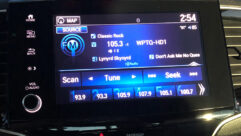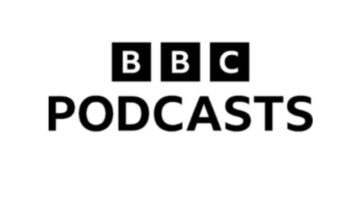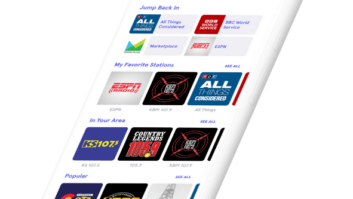LAS VEGAS The young U.S. satellite radio industry isn’t waiting for terrestrial radio to react to its recent gains. XM and Sirius are moving to generate more subscribers as each seeks to break even or better in 2004-05. Their strategies include trying to poach listeners from each other and terrestrial radio.
The efforts include regional traffic and weather services, something terrestrial radio leaders had feared, considering it a threat to radio’s traditional monopoly on that information.
Some broadcast engineers told Radio World during the recent CES show that the introduction of such programming by the satellite companies was inevitable.
Although XM and NAB recently reached an agreement for suggested language regarding the FCC’s terrestrial repeater rules – language that would bar XM from using repeaters to insert local programming – one engineer of a prominent radio group said he knew it was possible to deliver such regional programming without terrestrial repeaters. He suspects NAB was aware of it, too.
“They knew this was coming,” he said.
NAB President/CEO Eddie Fritts was quick to respond; and observers expect this tiff to continue for a while. The NAB Radio Board instructed the staff to keep pressing for “an explanation” on whether the satcaster’s plans violate their FCC authorizations for providing a national program service.
“Whatever NAB will do will be political. Don’t count them out,” said one head of engineering for a prominent radio group.
XM and Sirius say their services are national and they’re not violating their FCC authorizations for their service.
The FCC has not commented on the issue.
‘We’re legal’
Instead of inserting programming on local repeaters, XM and Sirius simply intend to add traffic and weather data that is available to all subscribers nationwide. For XM, each channel, however, will be devoted to a particular region. Sirius intends to let the subscriber’s receiver select which region’s material to broadcast.
Satcasters say this does not constitute local programming because it is sending all of the data with its programming on the satellite signals.
“What we are doing and have done is clearly consistent with all regulations,” said XM spokesman Chance Patterson. “There’s no issue here as far as whether we’re doing something consistent with our license or not. It’s all going through the satellite. It’s a nationwide service.”
He gave a sports programming example that could also apply to XM’s new traffic service, set to debut March 1.
“Say you’re a Washington Redskins fan. The game will be broadcast nationwide. Clearly the majority of people who would be interested in the game are in the Washington area, but fans in California can listen, too.”
XM has partnered with Mobility Technologies and The Weather Channel to offer dedicated traffic/weather channels for 15 cities in March, with plans to expand to 21 cities by the end of the year (Radio World, Feb. 1).
The roughly 4 kilobit-per-second channels would carry reports around the clock, every day. One broadcast engineer likened 4 kbps to 2 kHz of audio, roughly telephone quality. XM said the audio quality of the channels would be good.
A demo for Washington area traffic heard by Radio World lasted approximately 2 minutes and included extensive coverage of the beltway circling the Washington metropolitan area, as well as information on north and southbound I-95.
A listener will be able to punch up the report when he or she gets in the car, and plan a trip, instead of waiting to hear traffic and weather at predetermined times on terrestrial radio.
“I’d pay $10 a month for that,” declared a prominent radio engineer, referring to XM’s monthly subscription rate. There is no extra charge for the new traffic/weather channels.
“This is content that is useful for people who are on the nation’s roads, and our content is what separates us from AM and FM, the lack of commercials and programming that consumers desire,” said Patterson.
But another the head of radio engineering for another prominent group said, “I have a feeling they’re dialing down the bitrate for the program channels to develop enough channel bits for these new services. People will have to dial through some 100 channels to find (the traffic/weather.) Whether it’s good for consumers remains to be seen.”
Privately, an official with one of the satellite companies said it would be interesting to see whether terrestrial high-power AMs lengthen their traffic reports in response.
Sirius, too, is broadcasting all the traffic/weather data for locations over its satellite signals. Certain “flags” in the data enable a subscriber’s receiver to determine what traffic and weather locations would be preferred, and that radio only allows that information to be broadcast to that particular subscriber.
In 2005, Sirius plans to offer simple text traffic with information for a general area and later introduce advanced traffic with the addition of real-time weather reports. This service would tie in with any navigation system, Larry Pesce, executive vice president of product development, said.
Sirius also plans to add sports and financial data ticker data this year for no extra charge to subscribers.
XM music, no commercials
Also on the satellite front, XM is picking up a cue from rival Sirius and making all of its 68 music channels commercial-free this month. That has been a strong point-of-sale feature for rival Sirius.
XM executives hope the move will eliminate a big difference between the two digital satellite radio services when consumers learn about them from electronics retailers.
“It’s nice to set the standard,” said Sirius Retail Vice President of Retail Operations Bob Law, who recently joined the company from Kenwood.
That leaves programming offerings and price as differentiators between the satellite companies, with XM’s subscription price at $9.99 per month, nearly $2 less than Sirius.
Rolling out hardware is key to the race to break even. So is signing up more subscribers.
XM says it signed up more than 1.36 million subscribers in 2003, and had 1 million net additional subscribers for the year. Much of that increase came in the fourth quarter, with 20,000 subscribers signing up on Christmas day.
XM added more than 430,000 customers in that quarter and expects to have 2.8 million subscribers by the end of this year, close to the company’s break-even point of 3 million.
Sirius ended last year with 261,061 subscribers, up from approximately 30,000 subscribers at the end of 2002. It added more than 100,000 subscribers in the fourth quarter due to holiday retail sales.
But subscriber numbers alone don’t provide the whole picture of how the company is doing, said Sirius President/CEO Joe Clayton.
Sirius needs to reach about 2 million subscribers and XM needs about 3 million to get in the black, both have said. Why the difference? Sources say it has to do in part with how much money each company gives back to its receiver and auto partners per sale, and how much debt each satcaster is carrying. Both companies re-capitalized last year, but Sirius claims it has less debt than XM, making for a stronger balance sheet.
For those who would count out Sirius in the long run, Clayton said, “There are some who say that we’re not in the game. Forget about it. We are for real.”
XM President/CEO Hugh Panero countered, “It’s not what you announce … that matters, it’s what happens the next day and the next 12 months. While other companies are trying to generate smoke, XM’s on fire.”
In the skies
Fliers on some aircraft for JetBlue Airways and AirTran Airways will be able to experience that fire later this year for free.
XM will provide in-flight audio entertainment on flights using a system provided by LiveTV LLC, a wholly owned subsidiary of JetBlue. The XM in-flight service will be introduced on JetBlue’s existing fleet of Airbus 320 aircraft beginning this fall and on its new fleet of Embraer 190 aircraft when introduced into service next year.
AirTran will offer XM on its existing fleet of Boeing 717s this fall, as well as its new Boeing 737 aircraft when introduced into service.
XM and Sirius are exploring expanding into Canada. Both satcasters have applications into the Canadian broadcasting industry’s regulatory body. If successful, XM and Sirius would each devote two channels to Canadian programming, one in English and the other in French. As part of the application process, Canada would need to approve the installation of terrestrial repeaters.
XM’s Chairman Gary Parsons said the Canadian government also put out a call for proposals to open up the process to other companies. Those were due Feb. 16, he said.











